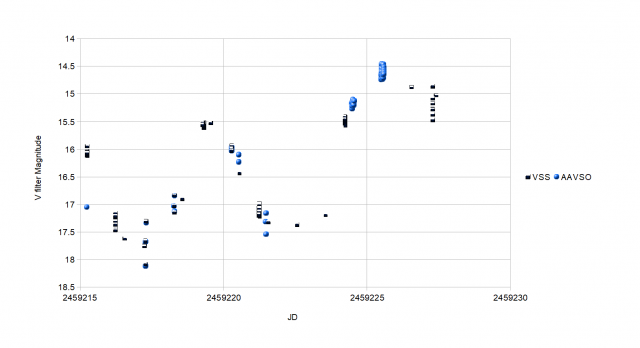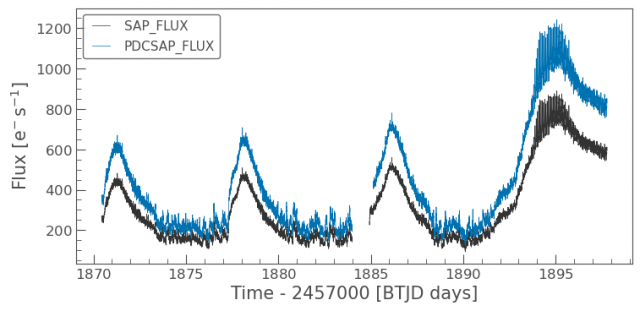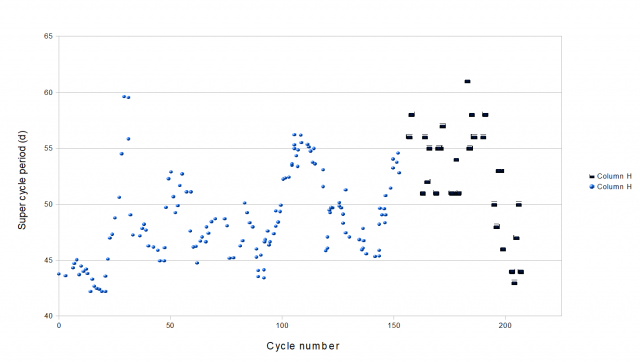Forum Replies Created
-
AuthorPosts
-
 Stewart John BeanParticipant
Stewart John BeanParticipantIn the next two weeks ER Uma will probably start a new superoutburst. This is based upon a superoutburst period of 55+/-5 days.
A graph of the superoutburst period against supercycle number is further up the thread – which shows this star “wanders” around 50 or 55 days for the super cycle period.
ER Uma is a good target in the spring. Observations are encouraged.
Stewart
 Stewart John BeanParticipant
Stewart John BeanParticipantIX Dra is approaching its March superoutburst. Based upon the current superoutburst period of around 60.5 days ( as described in VSSC 187) March 11 seems to be a likely start date. Yesterday IX Dra was at 17.4 V mag (AAVSOnet New Mexico) having risen from its quiescence low brightness of 18.0. It is possible there will be one more normal outburst and then the superoutburst as the time between outbursts is usually 5-6 days.
IX Dra is really a morning star at present, but is about 40 deg above the horizon at midnight in the UK.
Observations would be welcome over the next two weeks in order to determine the start of the superoutburst within a day.
Thanks in advance
Stewart Bean
 Stewart John BeanParticipant
Stewart John BeanParticipantER Uma probably in superoutburst at mag 12.6 V at 2021/01/17 04:44:36.
 Stewart John BeanParticipant
Stewart John BeanParticipantBased upon observations from both VSS and AAVSO members, the graph below indicates the onset of the January superoutburst.

I estimate the start time to be JD 2459224.2 which in turn gives a supercycle period of 61.7 days since the November event. Start times are arbitrary but in the absence of a definition (any ideas?) you have to go with something. The average value for P(sc) is then 60.5 days over the last eight cycles. Variations from this average only seem to be a few days so, with fingers crossed, we can mark our calendars for March 11 for the next superoutburst.
stewart
 Stewart John BeanParticipant
Stewart John BeanParticipantAAVSOnet BSM_NM gave 14.25 V Mag at UTC 2021/01/12 04:58:12 which is similar to the previous two superoutbursts.
 Stewart John BeanParticipant
Stewart John BeanParticipantJim deYoung (DEY) reports the following from Virginia USA:
Got IX Dra last two nights, about 2 hours first night then 2.5 hours last night.Not sure yet if super-humping but it is brighter than the standard inter-outbursts. Stewart John BeanParticipant
Stewart John BeanParticipantLooking at the last superoutburst graph ( up this forum on Jan 12th ), I see that there was quite a gap between the last normal and the normal outburst that led to the superoutburst. Immediately after a superoutburst the normals come every 3 – 4 days. Later they seem to be separated by 5-6 days. In the graph on the 12th Jan, it seems that there was a 7 day separation between the last two normals.
On this basis the next normal might be on the 12th. This one might trigger the superoutburst. If so it will be 5 days late relative to the recent long term average.
 Stewart John BeanParticipant
Stewart John BeanParticipantRobin , How bright does a star need to be to obtain a decent S/N ratio spectrum?
IX Dra is a bit faint perhaps, but ER Uma is brighter (V mag 13 maximum and better placed for observations ) and also approaching a superoutburst. See Discussion Forum on ER Uma and RZ Lmi.
Stewart
 Stewart John BeanParticipant
Stewart John BeanParticipantI got ER Uma at 13.44 at 2021/01/06 05:06:59 from AAVSOnet
ER Uma is showing increasing bright normal outbursts. Should be in a superoutburst during the next 10 days based upon a 45-50 day period.
RZ Lmi at 16.7 at 2021/01/06 05:18:54 again from AAVSOnet. Will be in superoutburst shortly as its period is only ~ 20 days.
 Stewart John BeanParticipant
Stewart John BeanParticipantT05 New Mexico gave 17.27 this morning at 2459222.01.
So still in a low state. Graeme Coates measured it at 16.0 on the 5th which may have been the peak of the last normal outburst. So that may mean another 3 days wait.
 Stewart John BeanParticipant
Stewart John BeanParticipantSorry Robin : DSS? I’m too new to this topic
I did get an image at 5:30am local from New Mexico and estimate V mag 17.1 +_0.33.
So we seem to observed a normal outburst at mag 16 on the 5th at 2459220.29 recorded by Graeme Coates.
Stewart
 Stewart John BeanParticipant
Stewart John BeanParticipantI am on a couple telescopes in New Mexico in few hours time. Had no luck with itel Spain owing to “roof closed”: clouded out.
Stewart
 Stewart John BeanParticipant
Stewart John BeanParticipantI also got Mag 15 on Jan4 from New Mexico AAVSO BSM NM2.
The only TESS record happens to show the approach to a superoutburst. The normal outbursts are ‘peaky’ or ‘trianglular’ at least compared to IX Da and RZ Lmi.

 Stewart John BeanParticipant
Stewart John BeanParticipantThat could be the last minimum before the superoutburst begins.
 Stewart John BeanParticipant
Stewart John BeanParticipantLast night’s result from AAVSOnet gave a V Mag of 13.5. Er Uma has displayed a series of gradually more intense normal outbursts. It is now 40 days since the start of the last superoutburst.
With a supercycle length of around 45-50 days in the present epoch the next superoutburst may occur shortly. The graph below shows how the supercycle period has varied over the last 200 cycles (27 years).

Previous superoutbursts have reached Mag 12.5.
Stewart
 Stewart John BeanParticipant
Stewart John BeanParticipantThe next superoutburst is expected in the first half of January.
IX Dra is now quite a difficult object for the USA based AAVSOnet telescopes that I have been able to use so far, although a couple of AAVSO observers ( Sweden and Virginia, USA) do seem to have reasonable northerly aspects and continue to report. AAVSOnet SRO Arizona is out of service at this time with a failed camera.
UK observers benefit from their higher latitude compared to the USA, but IX Dra has a very low elevation at this time of year.
If anyone can help for the period from Jan 1st to Jan 15th to capture the start of the superoutburst it would be appreciated. The most likely date for the start is in the middle of the window above – with the usual uncertainties.
Stewart
 Stewart John BeanParticipant
Stewart John BeanParticipantER Uma was at 14.7 last night down from 12.8 at maximum 13 days ago. So that superoutburst has been completed. The superoutburst period is around 40-50 days so about this time next month could be the next one.
RZ Lmi is in quiescence following a normal outburst on 3 Dec. The next superoutburst is due shortly as its super period is only about 20 days.
 Stewart John BeanParticipant
Stewart John BeanParticipantI was taught in Angstrom but adapted to nm in my professional life. You get used to anything in the end.
Stewart
 Stewart John BeanParticipant
Stewart John BeanParticipantThe November superoutburst is over, a return to quiescence at mag 17 and then a rise to 15.9 has been reported by AAVSO observers.
 Stewart John BeanParticipant
Stewart John BeanParticipantRZ Lmi was 14.26 at 2020/11/24 11:06:56 UT
ER Uma was at 12.8 at 2020/11/24 11:13:38 UT
Both were measured using AAVSOnet.
-
AuthorPosts
